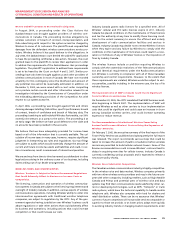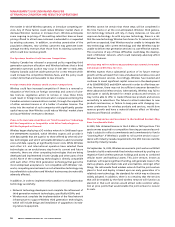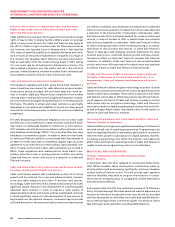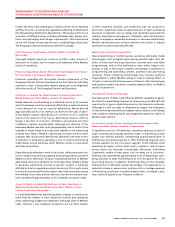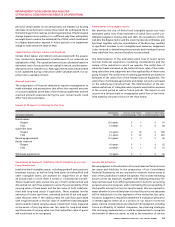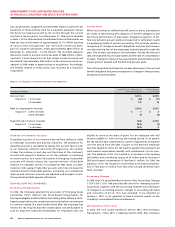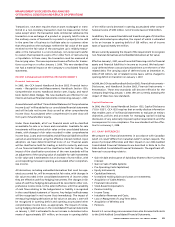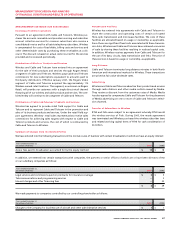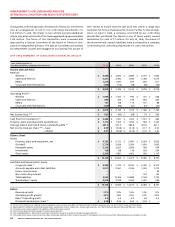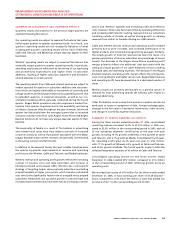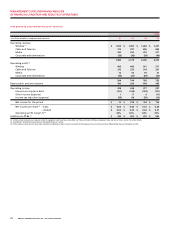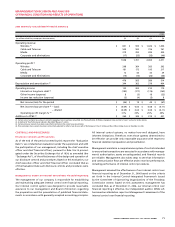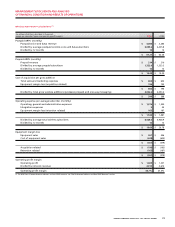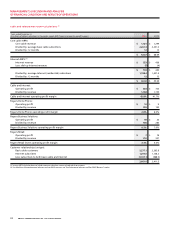Rogers 2006 Annual Report Download - page 69
Download and view the complete annual report
Please find page 69 of the 2006 Rogers annual report below. You can navigate through the pages in the report by either clicking on the pages listed below, or by using the keyword search tool below to find specific information within the annual report.
65
RO GER S CO MMU NIC AT ION S IN C . 20 0 6 ANN UA L RE POR T
MANAGEMENT’S DISCUSSION AND ANALYSIS
OF FINANCIAL CONDITION AND RESULTS OF OPERATIONS
Transactions. CICA 3831 requires that an asset exchanged or trans-
ferred in a non-monetary transaction must be measured at its fair
value except when: the transaction lacks commercial substance; the
transaction is an exchange of a product or property held for sale in
the ordinary course of business for a product or property to be sold
in the same line of business to facilitate sales to customers other
than the parties to the exchange; neither the fair value of the asset
received nor the fair value of the asset given up is reliably measur-
able; or the transaction is a non-monetary, non-reciprocal transfer
to owners that represents a spin-off or other form of restructuring
or liquidation. In these cases, the transaction must be measured at
the carrying value. The new requirements were effective for transac-
tions occurring on or after January 1, 2006. This new standard has
not had a material impact on the Company’s consolidated financial
statements.
RECENT CANADIAN ACCOUNTING PRONOUNCEMENTS
Financial Instruments
In 2005, the CICA issued Handbook Section 3855, Financial Instru -
ments – Recognition and Measurement, Handbook Section 1530,
Compre hensive Income, Handbook Section 3251, Equity, and Hand-
book Section 3865, Hedges. The new standards are effective for our
interim and annual financial statements commencing January 1, 2007.
A new statement entitled “Consolidated Statement of Comprehensive
Income (Loss)” will be added to our consolidated financial statements
and will include net income (loss) as well as other comprehensive
income (loss). Accumulated other comprehensive income (loss) will
form part of shareholders’ equity.
Under these standards, all of our financial assets will be classified
as available-for-sale or as loans and receivables. Available-for-sale
investments will be carried at fair value on the consolidated balance
sheets, with changes in fair value recorded in other comprehensive
income (loss). Loans and receivables and all financial liabilities will be
carried at amortized cost using the effective interest method. Upon
adoption, we have determined that none of our financial assets
will be classified as held-for-trading or held to maturity and none
of our financial liabilities will be classified as held-for-trading. The
impact of the classification provisions of the new standards will be
an adjustment of the carrying value of available-for-sale investments
to fair value and is estimated to be an increase of $212 million, with
a corresponding increase in opening accumulated other comprehen-
sive income.
All derivatives, including embedded derivatives that must be sepa-
rately accounted for, will be measured at fair value, with changes in
fair value recorded in the consolidated statement of income unless
they are effective cash flow hedging instruments. The changes in fair
value of cash flow hedging derivatives will be recorded in other com-
prehensive income (loss), to the extent effective, until the variability
of cash flows relating to the hedged asset or liability is recognized
in the consolidated statement of income. Any hedge ineffectiveness
will be recognized in net income (loss) immediately. The impact of
remeasuring hedging derivatives at fair value on January 1, 2007 will
be recognized in opening deficit and opening accumulated other
comprehensive income (loss), as appropriate. The impact of remea-
suring hedging derivatives on the consolidated financial statements
on January 1, 2007 is estimated to be an increase in derivative instru-
ments of approximately $571 million, an increase in opening deficit
of $10 million and a decrease in opening accumulated other compre-
hensive income of $393 million, net of income taxes of $168 million.
In addition, the unamortized deferred transitional gain of $54 million
will be eliminated upon adoption, the impact of which is estimated
to be an increase in opening deficit of $38 million, net of income
taxes of approximately $16 million.
We are currently assessing the impact of the requirement to recognize
non-financial derivatives and embedded derivatives at fair value.
Effective January 1, 2007, we will record all financing costs for financial
assets and financial liabilities in income as incurred. We had previ-
ously deferred these costs and amortized them over the term of the
related debt. The carrying value of deferred costs at December 31,
2006 of $59 million, net of related income taxes, will be charged to
opening deficit on transition on January 1, 2007.
In 2006, the CICA issued Handbook Section 3862, Financial Instruments –
Disclosures, and Handbook Section 3863, Financial Instruments –
Presentation. These new standards will become effective for the
Company beginning January 1, 2008. We are currently assessing the
impact of these two new standards.
Capital Disclosures
In 2006, the CICA issued Handbook Section 1535, Capital Disclosures
(“CICA 1535”). CICA 1535 requires that an entity disclose information
that enables users of its financial statements to evaluate an entity’s
objectives, policies and processes for managing capital including
disclosures of any externally imposed capital requirements and the
consequences for non-compliance. The new standard will be effec-
tive for us January 1, 2008.
U.S. GA AP DIFFERENCES
We prepare our financial statements in accordance with Canadian
GAAP. U.S. GAAP differs from Canadian GAAP in certain respects. The
areas of principal differences and their impact on our 2006 Audited
Consolidated Financial Statements are described in Note 26 to the
2006 Audited Consolidated Financial Statements. The significant dif-
ferences in accounting relate to:
• Gain On Sale and Issuance of Subsidiary Shares to Non-Controlling
Interest;
• Gain on Sale of Cable Systems;
• Pre-Operating Costs Capitalized;
• Equity Instruments;
• Capitalized Interest;
• Unrealized Holding Gains and Losses on Investments;
• Acquisition of Cable Atlantic;
• Financial Instruments;
• Stock-Based Compensation;
• Pension Liability;
• Income Taxes;
• Installation Revenues and Costs;
• Loss on Repayment of Long-Term Debt;
• Acquisition of Wireless; and
• Pensions.
Recent U.S. accounting pronouncements are also discussed in Note 26
to the 2006 Audited Consolidated Financial Statements.


